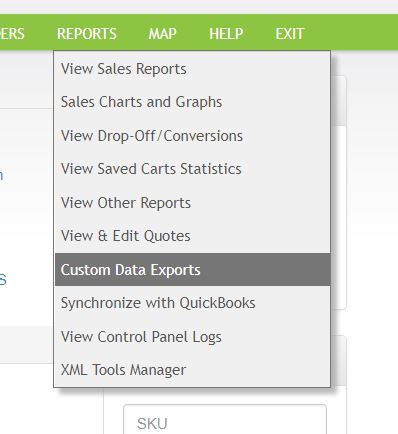Custom Data Export
Exporting information from your store
 ProductCart allows you to export a variety of data from your e-commerce store, including products, categories, orders, sales, etc. In some cases, you can export the information in
HTML, CSV, or MS Excel format. MS Excel will be shown as an available option only if ProductCart is able to successfully detect the presence of the application on the server. If MS Excel is not installed on the server, this option will be hidden (or a message will indicate that MS Excel does not appear to be installed).
ProductCart allows you to export a variety of data from your e-commerce store, including products, categories, orders, sales, etc. In some cases, you can export the information in
HTML, CSV, or MS Excel format. MS Excel will be shown as an available option only if ProductCart is able to successfully detect the presence of the application on the server. If MS Excel is not installed on the server, this option will be hidden (or a message will indicate that MS Excel does not appear to be installed).
Custom data exports
In a custom data export you will be able to select which fields to export (unlike with the pre-defined sales data export mentioned above).
To perform a custom data export select Custom Data Export from the Reports menu. In most cases, to generate an export file:
- Format
Select the format you would like the data to be exported in. The choices are: HTML table (the results are displayed in a browser page), CSV format (a comma-delimited file that you can download), or MS Excel. Remember that if MS Excel is not installed on the server, this option will be hidden (or a message will indicate that no MS Excel drives were found). - Date
Enter a date range using the format used elsewhere on your store. - Order Date
When you are exporting order related information, you can typically specify whether the system should use the date on which the order was placed, processed or shipped. - Order Status
When you are exporting order information, you can also specify whether incomplete, canceled, and returned orders should be included in the report.
Click on the submit button to generate the report. If you are exporting to HTML, the information will be shown in your browser. Depending on the amount of data that you are exporting, it may take some time for the report to be generated.
If you are exporting to CSV or Excel, a file will be generated and saved to the server. The confirmation page will include a link to the file. If you receive an error message, this is often due to folder permissions not being properly set.
 Unless otherwise specified, the file is saved to the “pcadmin” folder (which is typically renamed on a ProductCart-powered store). The folder must have “write” permission for the task to complete successfully.
Unless otherwise specified, the file is saved to the “pcadmin” folder (which is typically renamed on a ProductCart-powered store). The folder must have “write” permission for the task to complete successfully.
Export product and category information
You have two options:- Simple product export
Use this feature to export some of the most commonly used fields. Do not use this feature if you have a large product catalog. - Advanced product export (Export for Re-Import Wizard)
Use this feature to export more fields, and with larger catalogs. You will be able to search the products you wish to export (or divide the catalog into product ranges that are exported separately). - Advanced category export
You can also export category information.
Please note the following:
- Oversize
Oversize settings are exported as an array of values separated by a double pipe sign “||”. The array contains the 3 dimension and the weight in ounces (or grams). - Category Assignments
Category names are exported. If the product belongs to more than one category, category names are separated with a double star sign "**". - Removed/Deleted Product
When you delete a product from the Control Panel, the product remains in the database not to compromise historical order data, and its “removed” status is turned on (i.e. the database field contains a ”-1”). You can export this piece of information by checking this field. Products that have a ”-1” as the value in the field are not currently shown in the Control Panel.
Create data feed for Google Shopping
For information on how to fill out this section, see the Export to Google Products Search article under the Marketing topic of this support base.Export orders
Virtually every field in the “orders” table can be exported using this tool. Please note that product information is consolidated in one field to allow the export to a 1-line record (e.g. 1 line in an Excel spreadsheet). Use the Export Products Ordered tool to export details on the products that were purchased.Export ordered products
This feature allows you to export details on the products that were ordered within a specific date range. Each product that was purchased is a record in the export file. This means that an order can occupy multiple rows. If you need to recognize which products were ordered together, make sure to include the Order ID in the export file.Export orders to QuickBooks
If you have not yet installed the ProductCart Synchronizer for QuickBooks, clicking on this link will take you to an "About" page that will lead you to the features page for QuickBooks Sync. If you have already installed it, please refer to the QuickBooks Sync documentation within this support base to find out how to export orders to QuickBooks.Export customer information
This feature allows you to export the information that is saved in the “customers” table, including the custom Fields that can be managed under Customers > Manage Special Fields.Export affiliate information
This feature allows you to export basic information about the affiliate accounts in your store.Export order to FedEx
This export tool allows you to export orders in a format that can be imported into the FedEx Ship Manager. This allows you to more quickly process shipment in the Ship Manager and print FedEx shipping labels (including shipping to a thermal printer).- Order Date Rage: specify a date range (when the orders were placed)
- Status: narrow the list of orders by order status (e.g. “Processed” orders only)
- Shipping Date: the date these orders will be shipped (defaults to today)
 Feature limitation: overall order information is exported. If the order contained multiple packages,
package-level information is not exported. You will have to divide up the shipment into multiple packages within the FedEx Ship Manager.
Feature limitation: overall order information is exported. If the order contained multiple packages,
package-level information is not exported. You will have to divide up the shipment into multiple packages within the FedEx Ship Manager.
Export addresses to UPS and USPS
You can choose either to export addresses for all customers or just for customers that have placed at least one order within a certain date range.ProductCart exports a file called “UPSAddresses.csv” or “USPSAddresses.csv” (depending on which shipping service you export for) and saves it to the “pcadmin” folder (which has likely been renamed on your store). If you cannot successfully export addresses (or cannot see the file when you FTP into the folder), make sure that “write” permissions on the “pcadmin” folder are correctly set.
See the sections on UPS vs. USPS below to understand what the files can be used for in each shipping service.
UPS
Exporting addresses for UPS provides data in a format that can be imported into the Address Book that is part of your account at UPS.com.
By allowing you to quickly populate your UPS Address Book, this feature will speed up the process of shipping packages via UPS for those ProductCart users that process their shipments by using the tools at UPS.com.
Of course, you don't have to export information to UPS.com if you prefer to print shipping labels directly in your ProductCart Control Panel, a feature that is now supported.
To import the data from ProductCart into your UPS.com account, log into your UPS.com account and click on Address Book > Import Addresses from the left-side navigation. On the window that is displayed, use the Browse button to locate the file on your computer, and select My UPS Address Book from the Original File Format drop-down menu. The file will be uploaded to UPS and your addresses will be imported into the Address Book.
 The process is not immediate. Click on View Import/Export Status after a few minutes to see if the import was performed successfully.
The process is not immediate. Click on View Import/Export Status after a few minutes to see if the import was performed successfully.
USPS
This feature allows you to avoid having to re-enter shipping information if you use the USPS Shipping Assistant to ship your Web orders. ProductCart exports a CSV file that is formatted for use with the Shipping Assistant.
 ProductCart now includes the ability to print shipping labels directly from the Control Panel, using the USPS Shipping Wizard. This feature remains useful for store managers that prefer using the USPS Shipping Assistant.
ProductCart now includes the ability to print shipping labels directly from the Control Panel, using the USPS Shipping Wizard. This feature remains useful for store managers that prefer using the USPS Shipping Assistant.